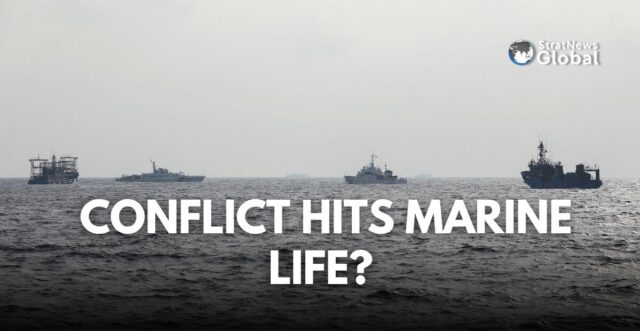Territorial tensions over the South China Sea have endangered its rich marine life, as scientists urge China and the Philippines to set aside their political differences to protect the ecosystem.
The 3.5 million square km sea, claimed in large part by China, has long been a source of conflict with the Philippines, particularly over the resource-rich Scarborough Shoal.
Environmental Damage Amid Political Disputes
The South China Sea has been at the centre of a decades-long dispute, particularly between China and the Philippines.
China’s installation of artificial islands and large-scale clam harvesting have caused severe damage to coral reefs, threatening marine life.
Filipino scientists estimate that over 4,000 acres of coral reef have been destroyed, and an additional 16,000 acres have been damaged due to these activities, leading to a decline in fish populations.
Deo Onda, a professor at the University of the Philippines Marine Science Institute, stressed the importance of moving beyond politics to focus on environmental preservation. “Amid this geopolitical tension… are the corals, the fishes, the invertebrates, and the organisms that are not privy to the politics,” Onda said. “Fishes do not have passports.”
The Urgency for Environmental Cooperation
Despite a July agreement aimed at de-escalating tensions, both countries continue to accuse each other of environmental damage.
While the Philippines recently announced plans to sue China for environmental harm in its waters, China has accused the Philippines of damaging coral reefs with a grounded warship, a claim denied by Manila.
However, scientists on both sides are pushing for cooperation to protect the ecosystem.
Marine geologist Fernando Siringan from the University of the Philippines points to years of economic exploitation and island-building by China as major contributors to coral destruction. “China’s island building was massive,” Siringan said, noting that the damage to coral reefs, which play a vital role in sustaining marine life, may be beyond recovery.
Threat To Marine Biodiversity
The South China Sea is home to one of the most diverse marine ecosystems in the world. It contains a significant portion of the Philippines’ coral reefs, which support a large percentage of the nation’s fisheries and seaweed industries. However, fish stocks have dramatically declined, with a 70% drop in numbers and a 50% reduction in species over the last three decades.
Marine scientist Charina Repollo emphasised the impact on local fishing communities, as the area traditionally provides high fish yields. She also highlighted the discovery of a new seaweed species that produces an anti-HIV compound, showcasing the potential for further scientific discoveries.
Need For Regional Cooperation And Data Sharing
Scientists agree that accurate assessment and monitoring of environmental damage are essential for any long-term solution. Filipino researchers, however, face challenges in conducting offshore surveys due to Chinese interference and limited funding. “One way to assert our sovereignty in this area is to have presence and activities, especially marine scientific research,” Repollo stated.
Wilfredo Licuanan, a coral reef expert, called for better mechanisms to monitor reef health and urged Southeast Asian countries to share data to support environmental conservation efforts. Recent joint maritime drills between the Philippines and Vietnam renewed interest in regional cooperation on marine protection, which scientists see as key to preserving the sea’s ecosystem.
“Marine environments do not have boundaries,” said Onda. He added that regional scientific collaboration could serve as “science diplomacy” and help de-escalate political conflicts.
(With inputs from Reuters)
Research Associate at StratNewsGlobal, A keen observer of #China and Foreign Affairs. Writer, Weibo Trends, Analyst.
Twitter: @resham_sng





